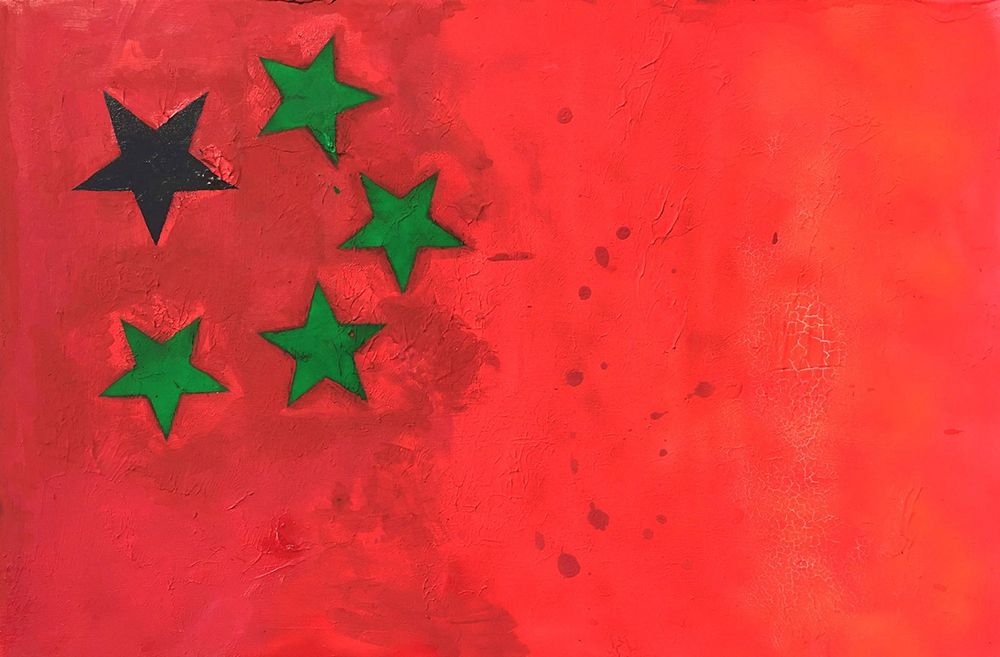
New York based-interdisciplinary artist Gerry Mak’s exhibition, Atomic Banana: Emotion and Hierospliffics, explores the mania of nationalist propaganda and its influence on the formation of the artist’s Asian-American identity. Mak considers derogatory terms like, “banana,” a slur used to describe people of Asian heritage who are born or raised outside of Asia, as well as ideologies associated with masculinity, nationhood, and pop culture to enunciate his personal struggles with information overload. The exhibit is on display now through December 1 at Waller Gallery.
Mak invokes a hallucinogenic aesthetic that remixes familiar iconography associated with American and Chinese nationhood— sports cars, flags, stealth fighters, space shuttles, weed paraphernalia, among other imagery, unpack his concerns about the irreverence of nationalism, capitalism, and patriarchy. The artist created “hierospliffics,” a stoner riff on the Ancient Egyptian writing system to deconstruct academic socio-political discourse into easily recognizable, but densely weighted symbols that confuse and disrupt their intended use as propaganda.
We recently got a chance to speak with Mak about what inspired this exhibition and what is work evokes about Asian-American culture in general.
How has your background informed your art?
A lot of it has to do with my identity and how I piece it together being a child of immigrants, a non-white person and how I’ve been drawn to symbols aesthetics and those kinds of propaganda and images [in] pop culture to try and inform my own narrative about myself and how I understand myself. I was thinking a lot about militarism, nationhood, national identity and how that is enforced with tech and the military. I wanted to be an astronaut when I was a kid. I watched the Challenger blow up when I was a kid. All of these things are part of my story.
My whole life I’ve been feeling apocalyptic and that the realities that we agree on are usually faulty and contradictory and very thinly propped up. Psychedelia is something that is really modern, contemporary, very American. Hippie culture and LSD has permeated everything. Growing up on Ren and Stimpy, even if you don’t consume drugs it’s so pervasive in our culture. It’s hard for it to not come out in the work. It’s hard to feel lucid about [it all] in the process. I’ve also been reacting to the overly cerebral rational kind of academic art which I have always been drawn to, [that is] very expressive and vulnerable.
The Destroy series, installed in Waller’s back gallery, are all black light reactive paintings. It is rare to see black light used outside of party scenes in a high art context or as a tool for political critique.
There’s something really tacky about black light. There’s a whole genre of poster art that is black light. I never saw it in an abstracted way or experimental. That whole series was spawned . . . it was the beginning, the earliest pieces in the work. I wanted to break free from representational, illustrative work, and be more expressive. That’s how those evolved and came about and one of the Destroy pieces, the character recurs. The character for “destroy” is on condemned buildings all over China [and] Beijing. It became a symbol for contemporary China. It’s a punk looking symbol. I’ve always been influenced by punk. It’s not anarchy and skulls, its actually used for practical reasons in China. [The character literally] translates to “disassemble, take apart.”
In your acrylic and spraypaint works, you appropriate the Chinese flag and Hong Kong flag and make something entirely new. What influenced those works?
I think a lot about how much people can identify with a flag. HK@NIGHT looks like a flower, [but] is the Hong Kong flag in black and white. It’s only been in use since 1997. My mother didn’t even recognize it. I feel like every place we’re talking about—China, Hong Kong, Europe, U.S., Africa, everywhere—there is a struggle with the idea of a national identity. Should there be one, is it possible to have one without historical grievances? The Hong Kong flag is 20 years old. How do people form attachments to things that are so young?